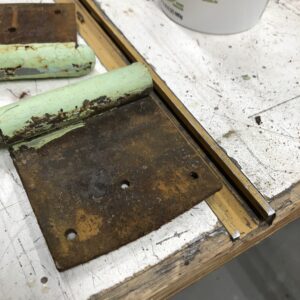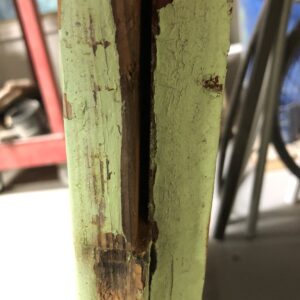My neighbor is rebuilding a couple of 100 year old doors from an old store. They are massive,10 feet tall.
The mystery is how the hinge mortises were cut. The hinge plates are mortised into the center of the edges of the stiles – into mortises that are 3″ high, 3″ deep and only 1/8″ thick. Instead of screws, nails were driven through and into the plate holes. The photos are not good, hope they show enough.
Anyone have any idea how to cut a mortise 3″ deep and only 1/8″ wide? I have a Japanese mortise chisel that is 0.175,” but that would leave some looseness, and due to the weight of the doors, we can’t have that.
















Replies
Is that stile one solid piece or two pieces laminated together?
If two piece, I think that would answer the question
Solid pieces - very solid - heartwood SYP, hard as a rock.
Narex makes a 4mm mortise chisel that's pretty beefy. That's 0.157", so you could have it ground to 0.125".
Second option is use the 4mm tool as is and add 1/32" metal plates as fillers. I imagine getting the top and bottom of the mortise square will be the main thing. A lock mortise chisel will help to clean out the inside as you go. It is a chisel with a hook bent into it for leverage.
Third option of course is fill those mortises and replace them with modern ball bearing hinges that will be good for the next 100 years. Re-using hinges with that much time on them is an iffy thing to do. Pretty cool though!
I'm confused. Do you mean 3" deep into the door and hinge thickness of 1/8"?
Yes, the hinge plates extend 3 full inches into the mortises.
Given the thickness of the hinge I have to think it’s not a mortised groove, but 2 pieces glued together. I know you said it’s a solid piece, I just don’t see how. Having said that, since it’s a rebuild, why not make it from a 2 piece glue-up? Too far along/too late?
".....a solid piece, I just don’t see how." That's the problem; we can't see how it was done. Absolutely certain its a single piece; we removed the 14 layers of paint to examine the grain, and its solid.
He has decided to start anew, as there is just too much rot, mostly at the bottoms. finished the rail mortises and tenons today. He hasn't decided how to handle the hinges, and I won't be around for a couple of days to see - so it will be a surprise.
You’ll have to fill us in when you have the solution! Let us know!
Narex makes a 3mm chisel as well - https://smile.amazon.com/dp/B00V922QT6?tag=amz-mkt-chr-us-20&ascsubtag=1ba00-01000-org00-mac00-other-smile-us000-pcomp-feature-scomp-feature-scomp&ref=aa_scomp_srsr2
Other manufacturers do make 1/8" mortise chisels.
I have an older Japanese 3 mm mortise chisel. But, it has a crack in the body I haven't had fixed yet. It works for shallow mortises now, but a 3" deep one would probably lead to a quick demise. Not that I'd give it up anyway, I find it very, very useful.
I'd have to think the stile is laminated too.
A door that size is probably late 19th century. It's conceivable the factory had a mortiser that could cut a mortise that narrow and deep. I sure wouldn't want to do it by hand.
Any evidence of a glue line along the stile edge?
A laminated door would also be stronger and more stable.
The original the OP has could have been solid, ripped and glued back together aligning the grain.
It certain;y could be solid but few would go through the trouble for such a thing.
Is there some hidden benefit of having the hinge mounted this way that we don't know about
I would guess that they had some kind of machine to do this.
I've toured a few production woodworking shops from the 19th century, and the ingenuity of specialty machines from that time is amazing. They'd essentially make early versions of today's machine tools and power them with a distributed belt-drive system from a water wheel. Incredible stuff. I wouldn't be surprised if they'd rigged up a slot mortiser for their doors.
I remember seeing a tool that works on the principle of a chain saw and can cut deep thin mortices.
I can't add anything to the above discussion. However, I am very curious as to how these doors, with the hinges in the center of the style, are able to fully swing. How was the other half of the hinge mounted? Was the wood trim and door jamb specially shaped to allow for door swing?
I was wondering the same thing, which is why I asked is there something we're not seeing?
Are there any "before" photos of the hinge in it's natural state?
I have not seen the building and door frame. We plan to see it this week.
I'll get some better photos of the mortises and stick the hinges in them.
For what it's worth, they do make a proper 1/8" wide mortise chisel. Though 3" is a deep mortise, it's not impossible for a craftsman in that era to do it by hand.
https://toolsforworkingwood.com/store/item/MS-MORT.XX
My smallest mortise chisel is 4mm and I can say I wouldn't want to cut that pocket for that hinge.
The point is, you don't go to that much effort unless it's necessary in some way. If this mortise is in the door, the frame must be unusual in design.
If I had to make one of those in a solid stile, I might groove the whole length on a table saw with a 1/8 blade. Put the hinges where they belong. Then fill in the remaining spaces with 1/8 shim stock.
I have a similar problem, would like to rebuild a window casement which is using this kind of hinges. I have no idea how it was built, but definitely this is not a multi-layer construction. Then, I came across (online, for now) a tool set called "hinge chisels", see 2nd picture attached. (I have zero experience with any of this). Presumably one would still need a normal narrow chisel. Any ideas ... thanks !
I think they were made with a special “Chain Mortiser”. This type of hinge was somewhat common in older large doors. Look it up. It’s like a plunging chain saw set up to create mortises.
This forum post is now archived. Commenting has been disabled